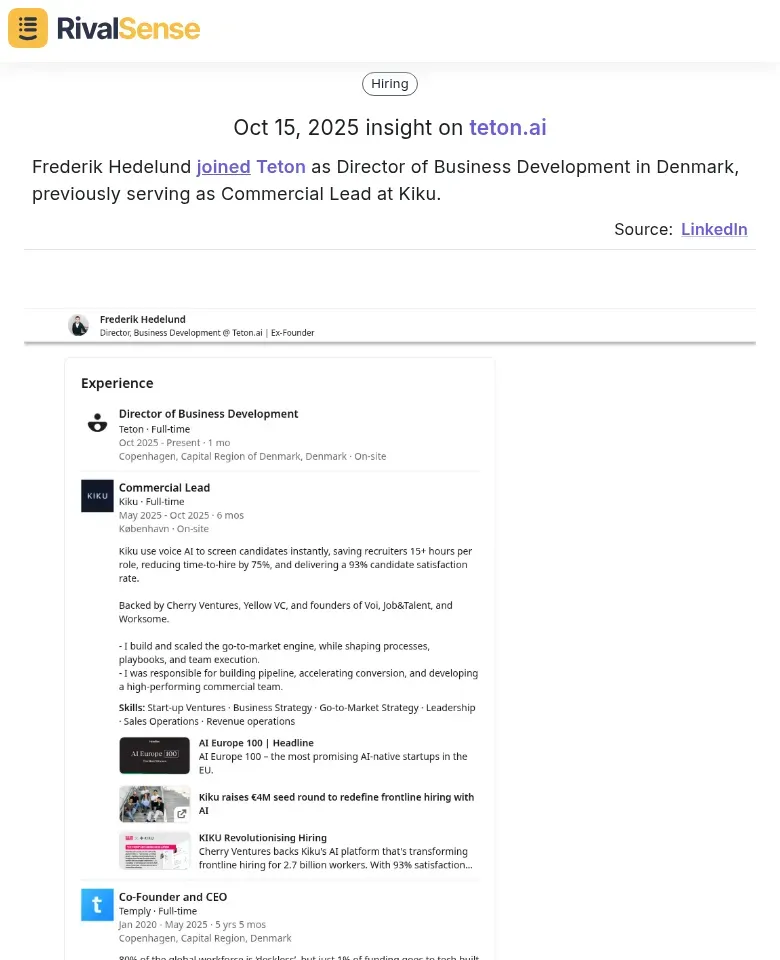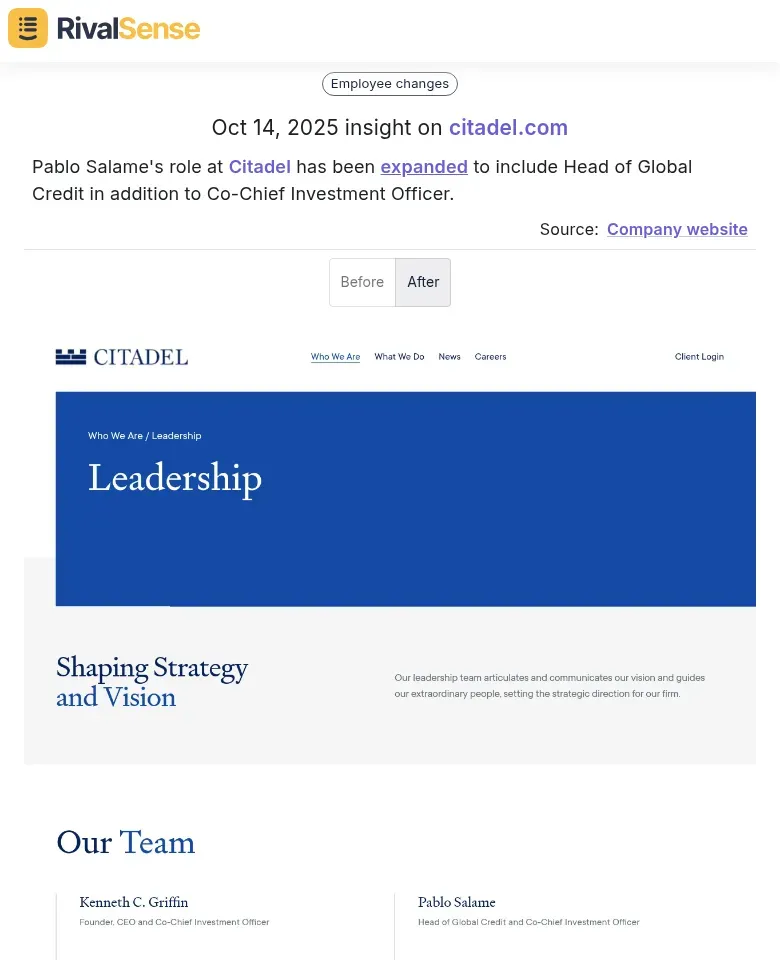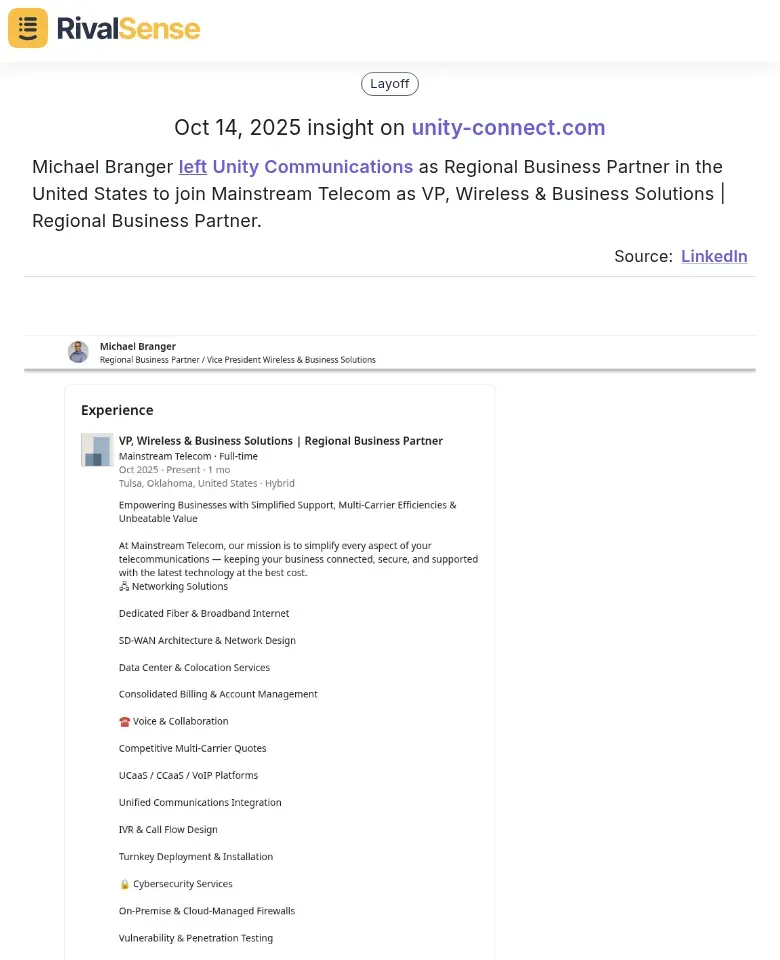Predict Hiring Trends: Track Key Account Employee Changes
Tracking employee changes in key account roles at competitors offers a strategic window into their evolving business priorities. When top account managers or sales leaders move between companies, it often signals strategic shifts—such as entering new markets, launching products, or restructuring sales approaches. For instance, if a competitor hires multiple enterprise account executives with healthcare experience, they may be targeting that sector. These talent flows provide predictive insights: increased hiring in specific regions or industries typically precedes market expansion, while departures from key roles can indicate internal challenges or strategy pivots. To leverage this intelligence, regularly monitor LinkedIn for role changes at competitor accounts, set up alerts for key personnel moves, and analyze hiring patterns quarterly to anticipate competitive moves before they impact your market position.
📈 Decoding Expansion Signals: New Hires in Strategic Roles
When competitors hire executives in new geographic regions or specialized roles, they're signaling expansion plans. Tracking C-suite appointments in unfamiliar territories—like a new VP of Sales in Europe—often precedes market entry there. Similarly, role transitions reveal talent strategies: when a rival poaches multiple AI engineers from tech giants, expect AI product launches soon.
For example, RivalSense tracked that Frederik Hedelund joined Teton as Director of Business Development in Denmark, previously serving as Commercial Lead at Kiku.  This type of insight is valuable because it highlights potential market expansion or strategic focus shifts, allowing you to anticipate and respond to competitor moves in emerging regions.
This type of insight is valuable because it highlights potential market expansion or strategic focus shifts, allowing you to anticipate and respond to competitor moves in emerging regions.
Practical steps:
- 🔍 Monitor LinkedIn for competitor executive changes in new locations
- ⚠️ Set Google Alerts for competitor hiring announcements
- 📊 Analyze job postings for emerging skill requirements
- 🔄 Track employee movements between competitors
- 🤖 Use tools like RivalSense to automate competitor hiring pattern analysis
Key indicators: sudden hiring spikes in specific departments, executive relocations to new markets, and consistent poaching from certain companies. These patterns help predict new service offerings—like when fintech competitors hire blockchain experts before launching crypto services.
🔍 Reading Between the Lines: Role Expansions and Internal Promotions
Role expansions and internal promotions provide deep insights into competitor priorities and organizational shifts. An expanded role—such as a sales lead gaining product management duties—signals increased investment in that function. Internal promotions, like elevating a marketing manager to VP, often indicate restructuring or strategic focus changes.
RivalSense captured Pablo Salame's role at Citadel being expanded to include Head of Global Credit in addition to Co-Chief Investment Officer.  Tracking such role expansions is valuable because it reveals internal restructuring, enhanced focus on specific business areas, or preparation for new initiatives, helping you adjust your competitive strategy accordingly.
Tracking such role expansions is valuable because it reveals internal restructuring, enhanced focus on specific business areas, or preparation for new initiatives, helping you adjust your competitive strategy accordingly.
Practical steps:
- 👀 Monitor LinkedIn for role changes in target accounts
- 📝 Note expanded responsibilities in job descriptions
- 📈 Track promotion frequency by department
- ⏱️ Compare role evolution timelines with competitor announcements
- 🛠️ Use tools like RivalSense to automate tracking and alert on significant changes
Analyzing promotion patterns across business units can identify where competitors are doubling down—frequent tech team promotions suggest R&D investment, while sales leadership changes may signal market expansion.
⚠️ Tracking Departures: What Employee Exits Reveal About Competitor Health
Employee departures from key accounts offer critical intelligence on competitor stability and strategic direction. When top talent leaves, it can signal internal challenges, retention issues, or cultural friction. For example, if a competitor's enterprise sales director overseeing your target market departs, analyze whether this reflects account instability or strategic shifts.
RivalSense identified Michael Branger left Unity Communications as Regional Business Partner in the United States to join Mainstream Telecom as VP, Wireless & Business Solutions | Regional Business Partner.  This type of insight is valuable because it highlights talent flow, potential vulnerabilities, or strategic realignments, enabling you to identify opportunities to gain market share or strengthen your position.
This type of insight is valuable because it highlights talent flow, potential vulnerabilities, or strategic realignments, enabling you to identify opportunities to gain market share or strengthen your position.
Patterns to watch:
- Multiple departures from the same account team may indicate client dissatisfaction or internal conflicts.
- Consistent talent loss suggests retention issues that could weaken their market position.
Practical steps:
- 🔎 Monitor LinkedIn for key account team changes
- ⏰ Track timing between departures and account performance dips
- 🗺️ Analyze if exits cluster around specific markets or products
- 🤖 Use tools like RivalSense to automate tracking and alert on significant moves
Employee exits often precede account losses or strategic retreats, so this intelligence helps you anticipate and capitalize on competitor weaknesses.
🛠️ Building Your Monitoring Framework: Tools and Best Practices
Building an effective monitoring framework requires the right tools and systematic practices to stay ahead. Start with essential data sources like LinkedIn Sales Navigator for real-time employee movements, Crunchbase for funding-related hiring, and specialized tools that aggregate multiple data streams. Monitor key metrics such as new executive hires, department-level growth rates, and employee churn patterns to uncover investment priorities and potential issues.
Best practices for integration:
- ⚡ Set up automated alerts for C-suite and key account changes
- 📊 Create a dashboard tracking competitor headcount by department monthly
- 🔗 Correlate hiring spikes with product launches or funding rounds
- 📅 Use employee tenure data to predict upcoming talent gaps
- 📑 Document hiring patterns in quarterly competitive intelligence reports
Practical checklist:
✅ Identify 3-5 key competitors to monitor
✅ Set up alerts for director-level+ hires
✅ Track employee growth in R&D vs sales departments
✅ Note hiring locations (predicting market expansion)
✅ Review hiring patterns before strategic planning sessions
By systematically tracking these elements, you can build a robust framework that provides actionable insights into competitor strategies.
🎯 Turning Insights into Action: Strategic Response Planning
When you spot competitors hiring aggressively in key accounts, it's crucial to act strategically and proactively. Develop counter-strategies based on talent flow data—for instance, if they're building a data science team, consider upskilling your existing team or forming strategic partnerships instead of engaging in direct hiring wars. Use insights to inform your own recruitment by analyzing which roles competitors are filling and adjusting your job descriptions to attract similar talent, while implementing retention bonuses for key employees in those areas.
Practical steps:
- 📅 Monitor hiring spikes weekly
- 🗺️ Map new hires to potential product launches
- 📋 Conduct SWOT analysis on their talent acquisitions
- 🔄 Update your recruitment playbook quarterly
Create early response plans by establishing a 'war room' with cross-functional teams (sales, marketing, product) to anticipate competitor market moves. For example, if they hire multiple enterprise sales leads, prepare targeted campaigns for your enterprise clients. Leveraging tools like RivalSense can automate tracking and provide alerts on key employee changes, ensuring you're always a step ahead in the talent game.
To effectively track these employee changes and gain predictive insights, try RivalSense for free at https://rivalsense.co/ and get your first competitor report today! This tool aggregates data from company websites, social media, and various registries, delivering weekly reports on product launches, pricing updates, event participations, partnerships, regulatory aspects, management changes, and media mentions—helping you stay informed and responsive to competitor moves.
📚 Read more
👉 How to Leverage Competitor Insights: Analyzing Dust's Frames Launch
👉 Free Competitor Analysis Tools: The Ultimate Guide to Staying Ahead in 2025
👉 How Media Buying Agencies Win with Competitor Customer Service Insights
👉 How Merchize's $2.5 Flash Card Launch Fueled Competitor Growth
👉 Case Study: Website Changes Reveal Competitor Market Research
